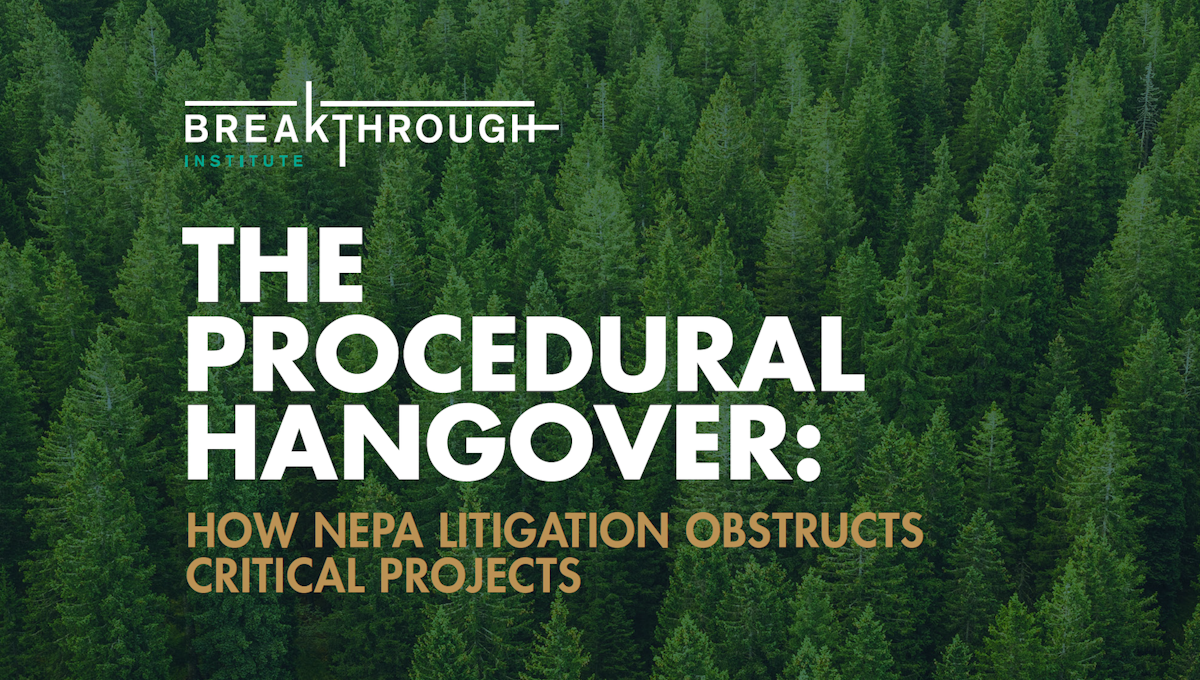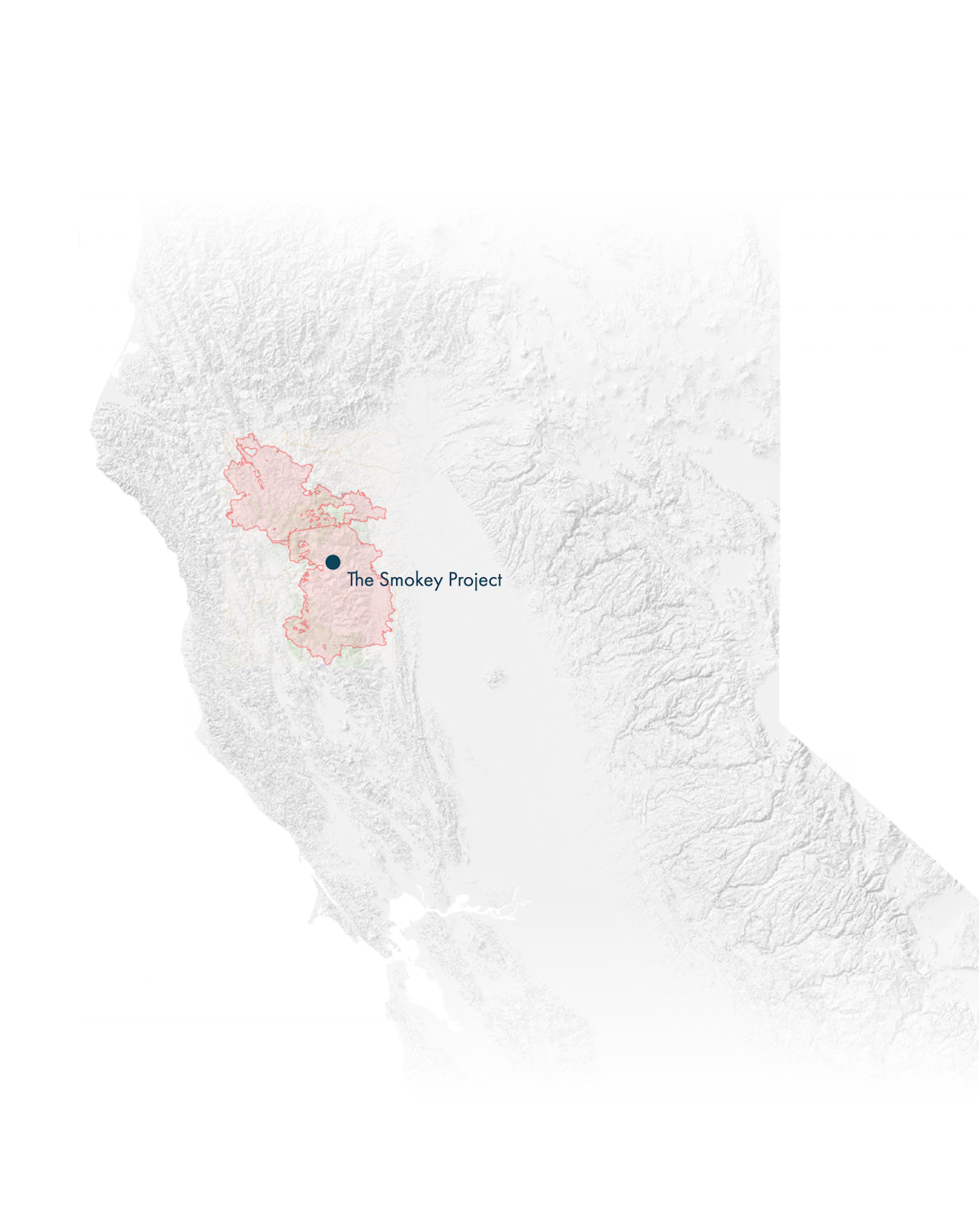The Procedural Hangover
How NEPA Litigation Obstructs Critical Projects

-
-
Share
-
Share via Twitter -
Share via Facebook -
Share via Email
-
In 2012, the U.S. Forest Service, in collaboration with private landowners and the Glenn County Resource Conservation District, finalized permitting paperwork under the National Environmental Policy Act (NEPA) to pursue the Smokey Project. The Smokey Project was a forest management project which aimed to perform about 7000 acres worth of treatment to mitigate wildfire risk in the Mendocino National Forest, due west of Chico, California.
The initial plan was to perform commercial thinning on 933 acres, prescribed fire and mechanical thinning on 3326 acres, precommercial thinning on 400 acres, and improve wildlife habitat on 1678 acres. Their original Environmental Assessment received a Finding of No Significant Impact (FONSI) in their original NEPA decision.
But before the project could proceed, the U.S. Forest Service—the most common agency defendant in legal claims under NEPA—was sued by Conservation Congress, an environmental organization based in Montana, claiming that the project did not comply with NEPA, the Endangered Species Act (ESA), and the National Forest Management Act (NFMA). Conservation Congress argued that the project failed to perform the due diligence to protect the Northern Spotted Owl, a species listed as “threatened” under the ESA, and therefore the agency’s “Finding of No Significant Impact’ was “arbitrary and capricious.”
The initial lawsuit, first launched in September of 2013, was litigated for three and a half years, before the Eastern District Court of California ruled in February of 2017 that the Forest Service and their partners did, indeed, fail to comply with NEPA’s standards by “failing to take a hard look” and “failing to develop a reasonable range of alternatives” in assessing the project’s impact on the Northern Spotted Owl’s habitat. The court ordered an injunction on the project until the Forest Service provided supplementary information clarifying the project.
The Forest Service and their partners obliged and the court ruled in March of 2018 that the Smokey Project was no longer considered in violation of NEPA, thus dissolving the injunction. Conservation Congress appealed the decision, but the Ninth Circuit Court ruled in June of 2019 that the Forest Service did not violate NEPA.

But before the project could begin in earnest, the August Complex Fire—the largest fire in California’s history—erupted, and burned over the entirety of the Smokey Project designated land. The August Complex burned over 1 million acres, likely destroying large swaths of old-growth forest, impinging on Northern Spotted Owl habitat, and threatening biodiversity
The August Complex Fire, along with a number of other fires that burned in California and Oregon in the late summer and fall of 2020, produced a smoke gall that traveled as far as Sweden, and was a key contributor to the “orange skies days” in the Bay Area in early September.
It’s impossible to determine the degree to which the delay of the Smokey Project’s 7000 acres of hazardous fuels reduction meaningfully contributed to the August Complex Fire. But, by delaying the project for years, Conservation Congress likely did more damage to the natural habitat of the Northern Spotted Owl than any amount of Forest Service intervention could have. The fuels reduction steps could have dramatically reduced the impact of the fire, better maintained the ecosystem for more species, and protected the area of the forest designated by the project.
The Smokey Project is emblematic of the complicated and circuitous delay and obstruction imposed on major infrastructure projects by NEPA and related environmental regulation. We highlight this project because forest management projects account for the bulk of lawsuits under NEPA, as the analysis in this report will make clear. However, we also single out the Smokey Project because it illustrates the moral hazard at play in NEPA litigation. Plaintiffs regularly sue federal agencies intending to alter, delay, or cancel major infrastructure projects, putatively in the name of environmental protection. But these lawsuits often result in precisely the opposite: obstructing or delaying efforts to deploy low-carbon power generation, construct long-distance transmission lines, execute fuels reduction projects on public grasslands and forests, lower greenhouse emissions, and enable energy abundance.
Litigation under NEPA has long been understood to impose costly delays, bureaucratic gridlock, and government dysfunction, all yielding deleterious procedural effects on major beneficial infrastructure investments. However, due mainly to the limited availability of data and records of legal proceedings, the extent and scope of these effects remain poorly documented. While this report makes a significant contribution, it does not offer a comprehensive catalogue. A more complete and transparent record of NEPA litigation is essential to informing effective and accountable permitting policy. In 2024, the Breakthrough Institute published a major review of NEPA litigation at the U.S. Appellate Court level. That report analyzed 387 NEPA cases brought between 2013 and 2022. This report expands our original analysis to include over 1,400 cases filed in U.S. District and Circuit Courts.
These are the major findings of our analysis:
Infrastructure projects spent years in litigation under NEPA. The median project in this dataset spent 1 year and 7 months in legal proceedings following a court challenge. However, a meaningful subset (7% of projects) remained in litigation for more than 6 years, reflecting a long tail of extended delays.
Judges tended to defer to agency decisions under NEPA. Only 26% of rulings in our dataset found a legal flaw in the agency’s review and issued a remedy requiring the agency to revise or redo its analysis.
Projects in this dataset typically faced their first NEPA challenge less than 6 months after receiving a final agency approval. The overwhelming majority of NEPA lawsuits are filed well within the six-year judicial review window allowed by the Administrative Procedures Act.
Environmental nonprofits were responsible for the bulk of NEPA lawsuits. NGOs were involved in 75% of judgments in our study. One group appeared in 28% of energy project-related rulings, and three groups were represented in 48% of wildfire risk reduction decisions.
Forest management projects attracted more NEPA litigation than any other project type. Litigation added over two years to the review process for all forest management projects in our dataset. In nearly one in four rulings on hazardous fuels reduction efforts in fire-prone areas, courts issued an injunction or vacatur that halted project activities.
Energy projects across fuel types faced prolonged legal uncertainty. Regardless of outcome, energy projects spent a median of 3 years between final agency approval and final court decision, some taking decades to resolve.
Projects undergoing more complex environmental review appeared more frequently in court. Although full Environmental Impact Statements accounted for just 1% of NEPA reviews, they represented 37% of District Court and 42% of Circuit Court rulings.
NEPA litigation rarely advanced environmental justice efforts. Fewer than 6% of rulings in our dataset cited a challenge to an environmental justice analysis or argued that one should be conducted.
Download the Report Here Check Out Our Interactive Report Website Here





